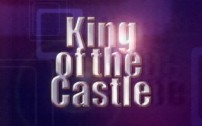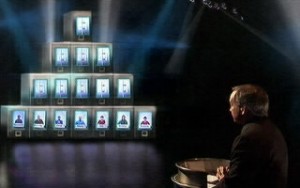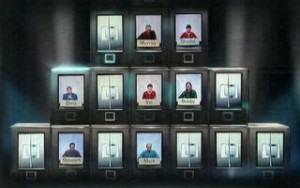King of the Castle

Synopsis
Alastair "Just look at this madness" Stewart off of London Tonight and Police! Stop! Exclamation Marks! tries to look mean and moody for this new daytime quizzer.
The basic aim is for the contestants to first get onto a four-level pyramid, then through a series of rounds aim to get to the top of that pyramid. If you're at the top when time's up, you're the King of the Castle.
 Coo! The genuinely impressive pyramid (ziggurat, really)
Coo! The genuinely impressive pyramid (ziggurat, really)In the opening round, we have nine contestants in a very long line. Basically, the first seven to get a question right go through to take a position on the pyramid. If a player buzzes in and gets the question wrong, they are effectively "wallied" (c.f. Bob's Full House) for the next question. Annoyingly, there aren't any lights, graphics or effects to indicate which player is currently wallied.
 "Can you point out the suspect from this lineup, madam?"
"Can you point out the suspect from this lineup, madam?"The first person to qualify gets to sit in the middle seat of the bottom row of the pyramid. At first this appears to be a set of physical booths, a bit like Celebrity Squares. But there's a trick up the sleeve, as we'll see in a moment. Anyway, the subsequent contestants that qualify sit in seats that are further away from the middle position, so that the 6th and 7th contestants take up either flank.
In the "first round proper", for all you Henry Kelly fans out there, Alastair asks questions to the seven in the order that they qualified. If they get their question right, they can either move themselves up/across one space on the pyramid (diagonals allowed) or move an opponent down/across one space. At this stage, the top King of the Hill space is not in play.
 The seven qualifying contestants are safely installed
The seven qualifying contestants are safely installedWhen a player chooses to move themselves or someone else, you're prepared for them to stand up and walk to a different chair in the kind of comedy Punchlines way. But! Here's the neato effect: the contestant just zaps from one position to the next. Yes, in fact this pyramid is a huge set of video screens onto which the faces of the contestants are being projected. It's a very clever gimmick.
As the game progresses, there are some mildly interesting game play choices going on - although rising to a higher level is important, it's also handy to be nearer the middle because there is more freedom of movement there. If the level above you is completely full, you haven't much choice but to try and bring a contestant down one level, but can you fill that gap before someone goes in before you? Etcetera. An annoyance is that people who buzz in and get a question wrong aren't penalised enough for our money, and again there's no graphic to say which contestant is currently sitting out.
 The contestants start moving around the game board
The contestants start moving around the game boardOnce each contestant has been asked two questions each, a further set of questions are asked on the buzzer. When time is up for this round, a maximum of two worst-performing contestants (i.e. those on the lowest level) are eliminated. If there are three or more, a sudden death question is used. When any contestants get booted off, Alastair comes out with an incredibly contrived catchphrase along the lines of "When it came to the end of the game, you just weren't ruthless enough." Ugh.
In the next round, the top three lines of the pyramid are used, and the game proceeds pretty much as before. The main difference is that you can choose to either answer a question as per normal, or answer a question in competition with one nominated player on-the-buzzer. If you win a buzzer question, you swap places with the person you pick on. You can only challenge a contestant in an adjacent (including diagonals) square, however.
 A one-on-one challenge in progress
A one-on-one challenge in progressAgain, another few people get booted off at the end of the round. The same kind of thing happens for the final round of buzzer questions, with the final two minutes counted down on the clock. Whoever is at the top of the heap at the end of this time is the winner and everyone else shuffles off the game board.
The winning player then goes on to a fairly bog standard money chase on a Pyramid Game-style board, with values ranging from £50 for one answer to £1000 for eight - all to be answered within one minute.
 The money chase. Yawn.
The money chase. Yawn.So, does one really neat visual gimmick a game show make? Not really. First up, in a death match between Alastair Stewart and Anne Robinson we know who would win. ITV have already tried to do an anti-The Weakest Link in the form of It's Not the Answer and we guess Stewart's demeanour is an attempt at the opposite notion. But it's such an obvious attempt to copy TWL that it's almost laughable. It would have been better if they'd just tried to develop their own style.
 Host, Alastair Stewart
Host, Alastair StewartSecondly, this show has the worst music we've heard in a long while. It plainly suffers from the sensation that it's been cobbled together on a fairly cheap set of synths. Millionaire and Weakest Link both realised that you need atmospheric music to fill in the dead air while contestants ponder about the answers. This show doesn't.
But the main problem seems to be that the board just gets too cramped in the later stages of the game for there to be any interesting tactics. It also seems unfair that someone who has defended their position for most of the game can get turfed out at the last moment.
It's a shame really, because the programme has some nice ideas and the middle section of the game is nicely strategic with plenty of player interaction going on. However, the opening and finishing rounds are so dull that it drags the rest of the show down with it. Programmes devised by people whose surname is Ross are normally the dog's appendages, but this more like the monkey's nuts. Nuts with a tasty centre, though.
Catchphrase
Alistair's sign-off line: You are today's King Of The Castle. That is until another day...
Inventor
Simon Ross

